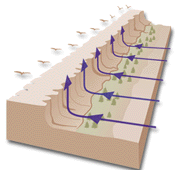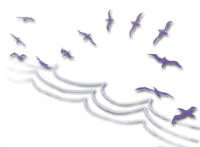 Diurnal migrants Most birds that migrate during the day (diurnal) are soaring birds such as hawks, storks, pelicans, cranes and swallows. Rather than using their own energy to fly, like powered flyers, soaring birds depend on the rising air currents and wind to provide lift. There are a variety of ways they can gain altitude and speed as described in some examples below.
Flying at a lower altitude, soaring birds take advantage of the updraft of wind
deflecting off trees and ridges. Given steady wind and a long ridge, a bird can travel 300
miles in one day. Thermal spiraling
Hawks and raptors, mainly solitary birds, form flocks to locate thermals more easily during migration. Dynamic soaring Some seabirds such as albatross, shearwaters, pelicans, gulls and terns migrate over water. Although not dependent on soaring flight, they take advantage of the wind currents blowing over the waves. By soaring and gliding, they greatly reduce the amount of energy required for extremely long distances. Some seabirds travel more than 12,500 miles each year.
Flapping migrants fly primarily at night and in the early morning. Soaring migrants fly during the day when warm air rises and gives them a lift.
|
Illustrations and text by LORI A. GALLO/Courier-Post
Sources: How Birds Migrate by Paul Kerlinger, Bird Migration by Chris Mead, Zoobooks
by John Bonnett Wexo, Birding by Joseph Forshaw, Steve Howell, Terence Lindsay,
Rich Stallcup
 Ridge gliding
Ridge gliding  As the earth is heated by
the sun, warm air begins to rise, creating thermal uplifts. As the day progresses,
thermals grow stronger and reach higher altitudes. Birds depend on this rising air to gain
altitude and speed, soaring in an upward spiral motion.
As the earth is heated by
the sun, warm air begins to rise, creating thermal uplifts. As the day progresses,
thermals grow stronger and reach higher altitudes. Birds depend on this rising air to gain
altitude and speed, soaring in an upward spiral motion. 
